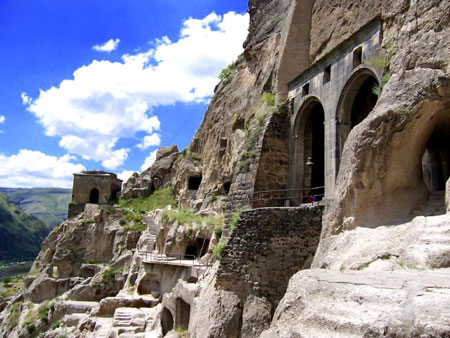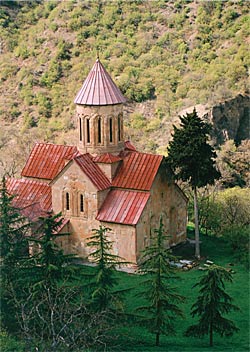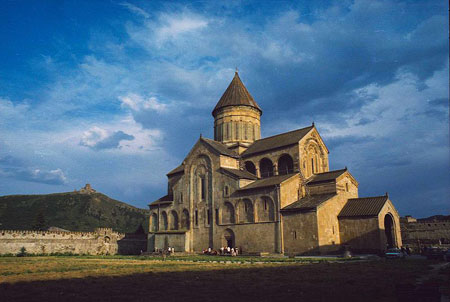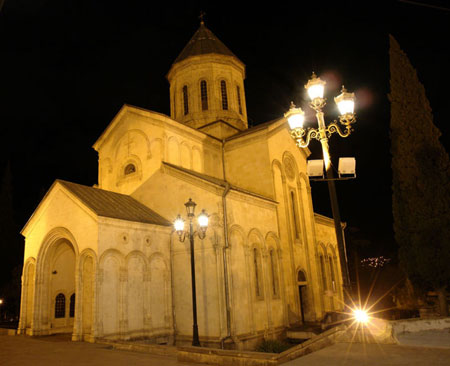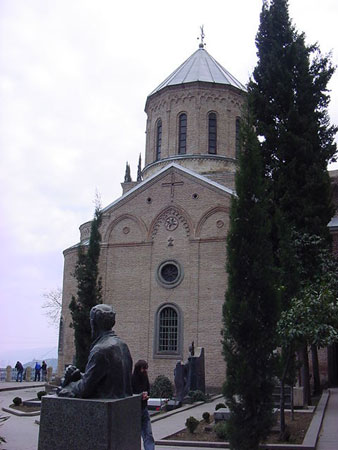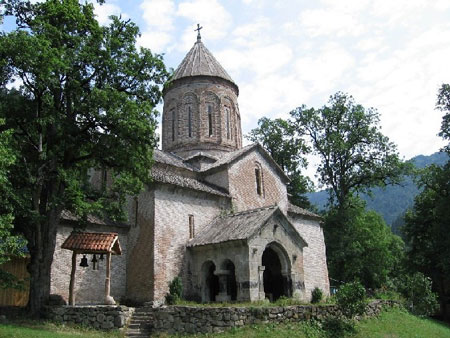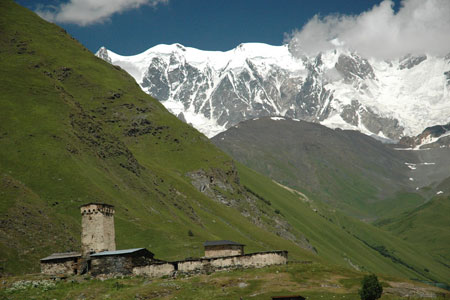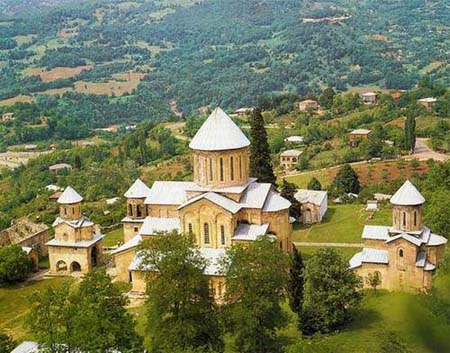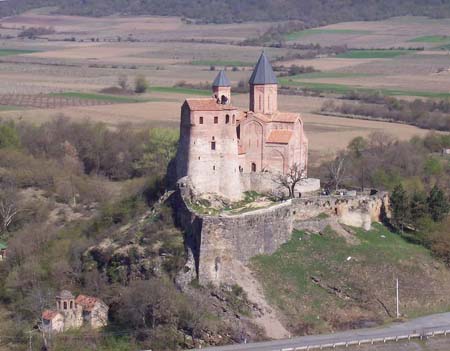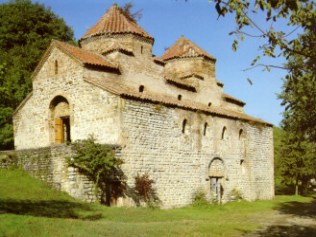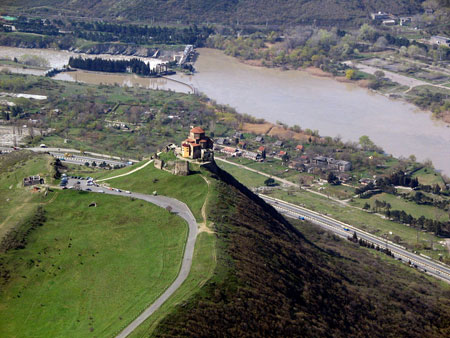Monasteries and Churches in Georgia (Gruzija)Vardzia Monastery
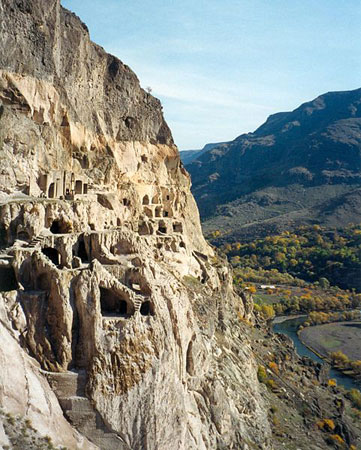
is a cave monastery dug into the side of the Erusheli mountain in southern Georgia near Aspindza. It was founded by Queen Tamar in 1185.
The monastery was constructed as protection from the Mongols. and consisted of over six thousand apartments in a thirteen story complex. The city included a church, a throne room, and a complex irrigation system watering terraced farmlands. The only access to the complex was through some well hidden tunnels near the Mtkvari river.
An earthquake in Samtskhe destroyed approximately two thirds of the city in 1283, exposing the caves to outside view and collapsing the irrigation system.
The church was reinforced and an externally visible bell tower added during the reign of Beka Jakheli in the thirteenth century.
Persians commanded by Shah Tahmasp I raided the monastery in 1551, capturing all important icons and effectively ending the life of the monastery.Batania Monastery
In 20 kms. from the capital the working man's monastery Batania (XII-XIII centures)is located., taht is considered by one of the best samples of Georgian temple architecture.Gergeti Holy Trinity Church

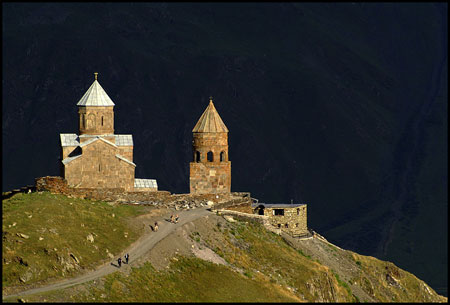
Gergeti Trinity Church is a popular name for Holy Trinity Church (Tsminda Sameba in Georgian) church near the village of Gergeti. The church is situated on the right bank of the river Chkheri (the left tributary of the river Terek), at an elevation of 2400 meters, under Mt. Kazbegi. It was built in the 14th century.Svetitskhoveli Cathedral
Svetitskhoveli Cathedral is a Georgian Orthodox cathedral located in the historical town of Mtskheta, Georgia, 20 km (12.5 miles) northwest of the nation's capital of Tbilisi.
Svetitskhoveli, known as the burial site of Christ's mantle, has long been the principal Georgian church and remains one of the most venerated places of worship to this day. It presently functions as the seat of the archbishop of Mtskheta and Tbilisi, who is at the same time Catholicos-Patriarch of All Georgia.
The current cathedral was built in the 11th century by the Georgian architect Arsukisdze, though the site itself is even older dating back to the early 4th century and is surrounded by a number of legends associated primarily with the early Christian traditions.
It is the second largest church building in the country, after the recently consecrated Tbilisi Sameba Cathedral, and is listed as an UNESCO World Heritage Site along with other historical monuments of Mtskheta.
The original church was built in IV century A.D. during the reign of Mirian III of Kartli (Iberia).Anchiskhati Basilica
According to the old Georgian annals, the church was built by the King Dachi of Iberia (circa 522-534) who had made Tbilisi his capital. Originally dedicated to the Virgin Mary, it was renamed Anchiskhati (i.e., icon of Anchi) in 1675 when the treasured icon of the Savior created by the twelfth-century goldsmith Beka Opizari at the Anchi Monastery in Klarjeti (in what is now part of northeast Turkey) was moved to Tbilisi so preserve it from an Ottoman invasion. The icon was preserved at the Basilica of St Mary for centuries (it is presently on display at the Art Museum of Georgia).
The basilica was damaged and rebuilt on several occasions from the 15th through 17th centuries due to wars between Georgia and the Persians and Turks. The brick belfry near the Anchiskhati Basilica was built by Catholicos Domenti in 1675.
The look of the structure was drastically changed in the 1870s, when a dome was added. During the Soviet occupation of Georgia, all religious ceremonies at Anchiskhati Basilica were halted, and the building transformed into a museum for handicrafts. It was later used as an art studio. From 1958 to 1964 restoration works took place in celebration of the 1500th Jubilee of the founding of Tbilisi, which changed the view of the church back to the seventeenth-century version, however, it was not until 1989, after the independence of Georgia was restored, that the basilica reverted to religious use.
The Anchiskhati Choir based out of the Anchiskhati Basilica is the world's leading exponent of Georgian polyphonic choral music.Kashveti Church
The Kashveti Church of St. George is a Georgian Orthodox church in central Tbilisi (capital of Georgia), located across from the Parliament building on Rustaveli Avenue.
The Kashveti church was constructed between 1904 and 1910 by the architect L. Bilfeldt, who based his design on the medieval Samtavisi Cathedral. The construction was sponsored by the Georgian nobility and bourgeoisie. Kashveti was built on the site of a damaged church built of brick at the request of the Amilakhvari family in 1753. Significant contributions to the current church’s ornate design were made by N. Agladze. Kashveti’s frescoes were painted by the influential Georgian painter, Lado Gudiashvili, in 1947.
The name "kashveti" is derived from Georgian words kva for "a stone" and shva "to give birth". Legend has it the prominent 6th-century monk David of Gareja was accused by a woman of making her pregnant in Tbilisi. David prophesied his denial would be proved when she gave birth to a stone. She did, and the place received the name of "k(v)ashveti".Davidgareja Monastery
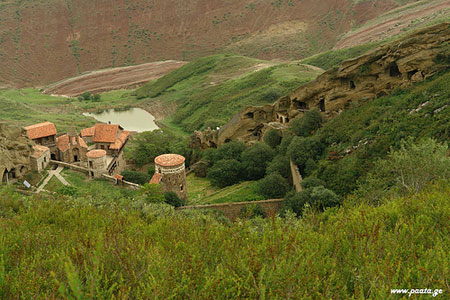
Davidgareja Monastery Complex is located in the Kakheti region of Eastern Georgia, on the half-desert slopes of mount Gareja. The complex was founded in the 6th century by one of the thirteen Syrian monks, who arrived in the country at the same time. David (St. David Garejeli) was builder of the first monastery (Lavra) of the complex. Later David's disciples Dodo and Lukiane founded two monasteries Dodo's Rka and Natlismtsemeli.
The most prominent saint of the 9th century Ilarion Kartveli (Ilarion the Georgian) greatly contributed to the development of this monastery complex. Later, it was supported by the Royal Court. Many prominent monks carried out their activities in Davidgareja. Among others was the son of the King of Georgia David the Builder (1089-1125), Demetre (Demetre I), the author of the famous Georgian religious hymn "Shen Khar Venakhi" ("Thou Art a Vineyard").
In the 11th century the Davidgareja monastery complex was invaded by Seljuk Turks.
In the 11th-13th centuries the economic and cultural development of Davidgareja reached its highest phase. New monasteries Udabno, Bertubani and Chichkhituri were built, the old ones were enlarged and re-organized.
The renaissance of fresco painting chronologically coincides with the general development of the life in the Davidgareja monasteries. The high artistic skill of Davidgareja frescoes made them an indispensable part of world treasure.
In the 13th century the Davidgareja monastery complex was invaded by Mongols. Davidgareja monasteries revived only a century later.
In 1615 numerous hordes of Persians led by Shah-Abbas annihilated all the monks, set fire to all unique manuscripts and important works of Georgian and world art.
At the end of the 17th century the monastery life was revived in Davidgareja. It was put to practice with the help of Onopre Machutadze. He was appointed Father Superior of Davidgareja in 1690.
In 1801 the Kingdom of Kartl-Kakheti (Eastern Georgia) was occupied by the Tsarist Russian Empire. In 1811 was abolished the Autocephaly of the Georgian Orthodox and Apostolic Church. In 1811-1917 Davidgareja was uninhabited. In 1921 the Democratic Republic of Georgia (1918-1921) was occupied by the Bolshevik Russia. In 1922-1980s Davidgareja was also uninhabited. Since restoration of the state independence of Georgia in 1991 was revived the monastery life in Davidgareja.
The complex is located along the Georgian border with Azerbaijan. In fact, a part of the complex is located on the territory of Azerbaijan proper. Border talks between Azerbaijan and Georgia, ongoing since 1991, recently re-entered the news in both the countries. In their recent comments, Azeri officials confirmed that Azerbaijan is open to implementation of joint projects with Georgia for the restoration of the complex. A number of fresh rounds of "border delimitation" talks have been conducted recently between Azeri and Georgian authorities (in Tbilisi and then in Baku).St. Kvirike and Ivlita’s Church
http://collections.lib.uwm.edu/cdm4/item_viewer.php?CISOROOT=/georgia&CISOPTR=21&CISOBOX=1&REC=8
The monastery of Kirrik and Eflit, one to two miles from the village of Kali.Motsameta Monastery
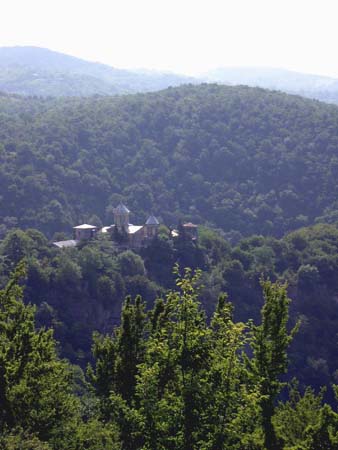
Motsameta monastery complex (8th-11th CC) is beautifully situated between the valleys of two rivers near Kutaisi. In the 8th century, brothers David and Konstantine Mkheidzes, the Lords of the region, were assassinated here by Arabs, for refusing to convert to Islam. The old church was destroyed. A present monastery complex was built on the site of the old church by King Bagrat in 11th century. "Motsameta" monastery means "monastery of martyrs". The sacred remains of the brothers are kept in the Crypt of the church.Mtatsminda Monastery
Mtatsminda - a holly mountain with the Holly Father David's church. The church dates from 1879 and was built on the original site of Saint David's cell. David came to Georgia as one of the thirteen Syrian fathers to preach Christianity. He has chosen this mountain, uninhabited at that time and slightly away from the town and lived there in a cell. The interior of the present church is fully decorated with frescoes. The church is surrounded by the Pantheon of Writers and Public Figures of Georgia.Timotesubani monastery
Timotesubani monastery - the Cathedral of Holy Virgin is a cross-cupola church built in 12-13th c . The interior of the church is decorated with best examples of Georgian mural painting of 13th c. The name of its architect as well as the name of the painter is unknown. Originally the church had a blue roof, as blue color was highly appreciated during the middle ages.Zarzma Monastery
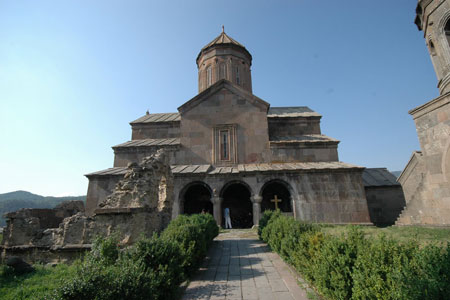
Zarzma Monastery was founded by confessor Serapion Zarzmeli in 10th century. In the same period King david Kuropalat built a chapel, cathedral and bell-tower. The main large domed church, almost quadratic in plan was built in the 14th century. The doors and windows are richly decorated. There is a 14th century mural painting in interior of the church. The frescoes represent portraits of the Jakheli - the former governors of the ancient Samtskhe region.Akhali Shuamta Monastery

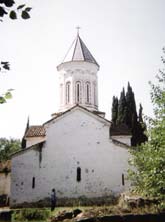
Akhali Shuamta (New Shuamta) nunnery complex is situated two kilometers from Dzveli Shuamta in a picturesque area along the Gombori Pass. The nunnery was built by Kakhetian King Levan II and Queen Tinatin in the 16 century. The complex includes a cruciform church with high cupola and a bell tower. The church is decorated with 16th century fine frescoes depicting the scenes of Christ's life as well as of the Royal Family: King Levan II, Queen Tinatin and their son Georgi.Alaverdi Cathedral
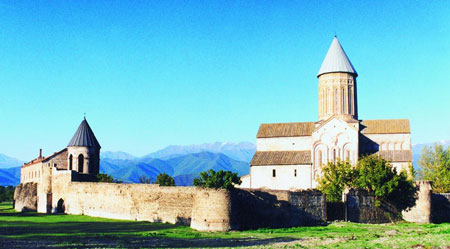
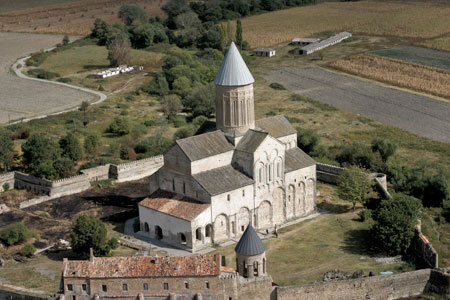
Alaverdi - cathedral is a symbol of blossoming of the Georgian culture. Built in 11th c - in a period of great cultural and political development of the country, it was one of the biggest Georgian structures and the tallest church of its time. The exterior is decorated with five elegant arches, the facade carries excellent stone decorations. These often represent vine and sun symbols. The mural painting was badly damaged during the centuries, but some frescoes are partially restored. Cathedral is surrounded by impressive defensive walls.Ananuri
Ananuri architectural complex belonged to the house of the Eristavi of Aragvi - a violent local ruler. The characteristic architectural design of the late medieval period includes a fortress, two churches, an old watch tower, prison and civic buildings. Located on the famous Georgian Military Highway it stood as a guardian to the Northern boarders of Georgia. A picturesque view of reservoir spread bellow opens from the base of the Ananuri Fortress.Ateni Sioni
Ateni Sioni is a masterpiece of monumental architectural art. It stands on a cliff side on the outskirts of a small village. The church dates back to the first half of the 7th century. It is built of carved greenish-grey sandstone which turns red when it gets old. It has two entrances: southern and northern ones. The walls of the church display unique Georgian writings of different periods. The murals, completed in the second half of the 11th century, follow the old Georgian traditional iconographical style. Most of the splendid frescoes are still visible today.
Bagrati church
Bagrati church of the Assumption of the Virgin was built by King Bagrat III in Kutaisi, in 1003 AD. It is a marvellous example of domed-church architecture from the high Medieval period, noted with impressive examples of stone carving. Partially ruined cathedral is situated on the top of the hill called Ukimerioni and commands a splendid view of Georgia's second city, Kutaisi. This was an ancient citadel, a royal palace and one of the most important castles from 6th to 17th c.Bolnisi Basilica
Bolnisi sioni is a three-nave basilica built in 5th c. The capitals and columns are decorated with geometric carvings, patterns depicting vegetables and pictures of birds and animals. The capital of the baptistery is decorated with a cross, peacocks and a bull head with another cross between its horns. Bolnisi Sioni has Georgia's most ancient inscriptions dating from the late 5th century, mentioning Bishop David and King Peroz.The churches of Svaneti
The churches of Svaneti are mainly single-nave basilicas of the 8th-9th-14th cc., built with stone, without facade ornamentation. The interiors are uniquely unmolested for Georgia and usually richly decorated with frescos painted by artists Michael Maglakeli and Tevdore ("King's artist"). The frescos are mainly 10th-12th cc; the main churches are Kvirike and Ivlita, Ipari, Nakipari, Lenjeri, Latali, Tangili.Gelati Monastery
Gelati complex comprises the churches of the Virgin (the main church), of St Nicolas, of St. George, as well as the academy which was the centre of cultural and spiritual life. The Gelaty monastery complex was founded by King David the Builder in the 12th c. It is noted by the finest examples of Georgian mural painting. Among them is the only surviving portrait of King David the Builder whose grave can be found at the gateway of the monastery. The giant 12th century mosaic of the Virgin with Child is completely unique.Gremi
Gremi - architectural complex of 16th-17th cc was built by King Levan and Queen Ketevan on a rocky hill. In the 16th c Gremi was the capital of Kakheti Kingdom, but all that remains of the former town are some ruins of a market, baths, caravanserai and a palace. The present complex used to be a citadel and consists of a tower, king's chambers, defensive walls and a central-dome Archangel's church built of square bricks. The interior of the church is decorated by frescoes of 17th century.Gurjaanis Kvelatsminda Church
Gurjaanis Kvelatsminda - The Church of the Dormition of the Virgin is situated in a forest, two kilometers from the town of Gurjaani. This church is a unique example of twin-domed architecture in Georgia. The complex was destroyed by invaders, and rebuilt and repaired several times by local nobles and Georgian kings. It offers a graphic example of the new type of large cathedral with several chapels.Jvari
Jvari is a masterpiece of the early Medieval Period. It stands on a mountain opposite the ancient city of Mtskheta. St. Nino erected the first wooden cross at the site. Its pedestal can still be seen in the centre of the church. This example of classic tetra conch design with all its miniature size, strikes the viewers with its grandeur and integrity. The interior, once decorated with mosaics is rather bare today, but a spectacular view opens from the church, which is seen from far away, equally well from all directions.
